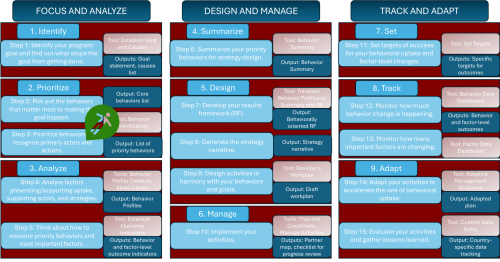Priority behaviors are those behaviors closest to your goal that impact on your goal. From your list of core behaviors (in Step 2), which are directly related to addressing the causes stopping achievement of your goal (from Step 1), you filter out possible behaviors. Your goal is to land on the set of behaviors that are truly a priority for your program and that are the most proximal to your goal.
Priority behaviors are the driving force of your program. You determine your behavior outcomes – the results of your program – based on your priority behaviors.
To reduce your list from all possible behaviors to the highest priority ones, you take your brainstormed core list of behaviors and ask yourself a few starting questions:
- What will happen because of this behavior?
- Does it have a direct impact on our goal?
For example, if your goal is “reduce infant mortality by 10% from [year] levels”, then the impact you want to see is “the baby will survive!” Building on the same example from Step 2, in the list of core behaviors below, the ones that will help the baby survive are highlighted in bold orange font.
- Mothers exclusively breastfeed for the first 6 months
- Expectant fathers support pregnant partner to deliver in a facility
- Local governments adequately fund postnatal care
- Traditional birth attendants refer women to health facilities for delivery
- Pregnant women sleep under an insecticide-treated net every night
- Pregnant women deliver in a health facility with an equipped, qualified provider
- Grandmothers-to-be encourage early initiation of breastfeeding
- Caregivers provide essential newborn care immediately after birth
- Caregivers seek prompt and appropriate care for signs and symptoms of newborn illness
- Service providers treat pregnant women with respect
- Logistics officers ensure a consistent supply of all essential commodities, including contraceptives
The rest are still actions, but for your supporting actors, not for your program priority behaviors. Sometimes you’ll feel that a supporting actor’s action or behavior is so important that you need to elevate it to the status of priority behavior. That’s okay too. If you feel it’s important, trust your evidence and insight and do it. BIG is flexible. Adapt it to meet your needs. (That’s what we would do in your shoes. As long as it’s evidence driven.)
Once your initial list of core behaviors has been reduced, ask yourself some more questions. This will help you make one final cut and focus on only behaviors that will truly help you achieve your goal. Ask the following questions about each behavior left on your list (the bold orange highlighted ones from above).
- To what extent is this behavior a priority for the government?
- To what extent is this behavior a problem?
- To what extent is this behavior sufficiently changeable in the next year, two years, or five years?
- To what extent is the potential change in this behavior worth the resources that would be required to invest to change it?
- To what extent is this behavior within your organization's abilities and interests, considering agency mandates, staffing requirements, etc.?
- If this behavior is being addressed by other donors, to what extent should your organization also support, or focus on, this behavior?
Those behaviors that rate “higher” than other behaviors are your final, key priority behaviors. A higher rating means they are more of a priority, a bigger problem, really worth the investment, etc. They earn priority status because they are both closest to helping you achieve your goal and support important contextual issues relevant to your program.
Evidence is necessary to answer some of these questions. So, refer to the quantitative and qualitative data you gathered when determining your causes (Step 1). And use our detailed data by health topic or by country for select health behaviors.
Finished your priority behaviors list? Oh wow, you are on a roll! (We love momentum.) Let’s move on to analyzing these priority behaviors so that you have what you need to develop your behavior strategy.




 The Manoff Group was acquired by JSI in 2022.
The Manoff Group was acquired by JSI in 2022.